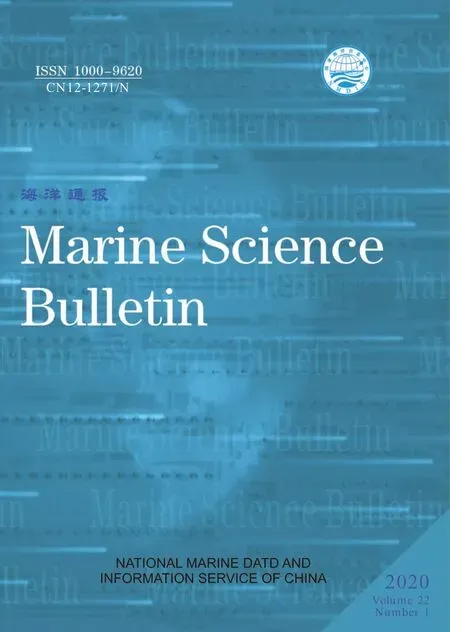The benthic diatom community of Xiangshan Bay
2020-08-12WURuiGAOYahuiLANDongzhaoLANBinbinFANGQi
WU Rui,GAO Yahui,LAN Dongzhao,LAN Binbin,FANG Qi
1.School of Life Sciences,Xiamen University,Xiamen 361005,Fujian province,China;
2.Hainan Academy of Ocean and Fisheries Sciences,Haikou 570125,Hainan province,China;
3.Third Institute of Oceanography,Ministry of Natural Resources,Xiamen 361005,Fujian province,China
Abstract:The samples collected from the surface sediments in Xiangshan Bay,Zhejiang province in May and November 2005 were analyzed under a light microscope.The species composition,abundance,community structure and diversity were investigated.A total of 179 taxa belonging to 46 genera of diatom were identified.The result showed that the ecotypes of diatom were mostly eurytopic species,followed by warm water species and temperate species.The most dominant species were Cyclotella stylorum and Coscinodiscus jonesianus.The seasonal variation of diatom abundance was remarkable.The cell abundance of diatoms was higher in spring(2.974×103 cells/g)than that in autumn(0.071×103 cells/g).The number of species varies with change of season,demonstrating the adaptability of diatoms to the temperature of water.The species diversity of benthic diatom was lower in autumn than that in spring.
Keywords:Xiangshan Bay,aquiculture,benthic diatom,community characteristic
Benthic microalgae,which can carry out photosynthesis at the sediment-water interface,are the primary producers in coastal waters.The biomass of benthic microalgae in coastal waters even exceeds that of phytoplankton in the upper water layer(Mac Intyre,1996).Benthic diatoms,the main type of benthic microalgae,are direct prey of marine animal larvae and also the main prey of some economically important mollusks(You et al.,1994;Chen et al.,1994).The study of the structure of the benthic diatom community is therefore of importance to the aquaculture industry.
Xiangshan Bay,located at the central coast of Zhejiang Province,China,is a northeast–southwest-oriented,narrow,semi-enclosed bay with an average water depth of 20 m and a watershed area of 1 740 km2(Zheng et al.,2004).It is one of the most important aquaculture bases in Zhejiang Province.The cage-aquaculture industry in Xiangshan Bay has developed rapidly since 1992,which has inevitably introduced much pollution and poses a direct threat to the local ecological environment.To ensure the harmonious co-existence of aquaculture ecology and the environment in Xiangshan Bay,basic research on aquaculture ecology need to be strengthened to explore the relationship between biological and environmental factors and the factors influencing them.In comprehensive investigations of the coastal areas of Zhejiang Province(Coastal zone and coastal resources comprehensive survey reporting committee of Zhejiang province,1988),many scholars have studied the ecological and physiological characteristics as well as the primary productivity of phytoplankton in Xiangshan Bay(Nin et al.,2002;Gu et al.,1993),but less attention had been paid to the distribution of benthic diatoms in sea water.Drawing on previous studies,this study investigated benthic diatoms and analyzed their species composition,distributional abundance and seasonal variation characteristics.
1 Data and methods
1.1 Sample sources
In May and November 2005,surface mud was collected from the seabed of Xiangshan Bay.Nine stations were set up(Fig.1).Stations 1,2,3,6 and 7 were located in the main port of Xiangshan Bay.Station 4 was located at the intersection of the main port and the branch port,Tie Port,while station 8 was located at the intersection of the main port and the branch port,Huangdun Port.Stations 5 and 9 were located at Tie Port and Huangdun Port respectively.There were no productive activities at stations 1 and 6.Station 2 was a fishing area,and a small number of fish cages were deployed at stations 3,4,5 and 7.A large oyster farming area was located north of station 5,and an oyster farming area was situated on both sides of station 8.Station 9 was surrounded by fish cages.Surface mud was collected in the uppermost 1 cm,packed in polyethylene bags and transported under cold storage conditions to the laboratory for analysis and determination.
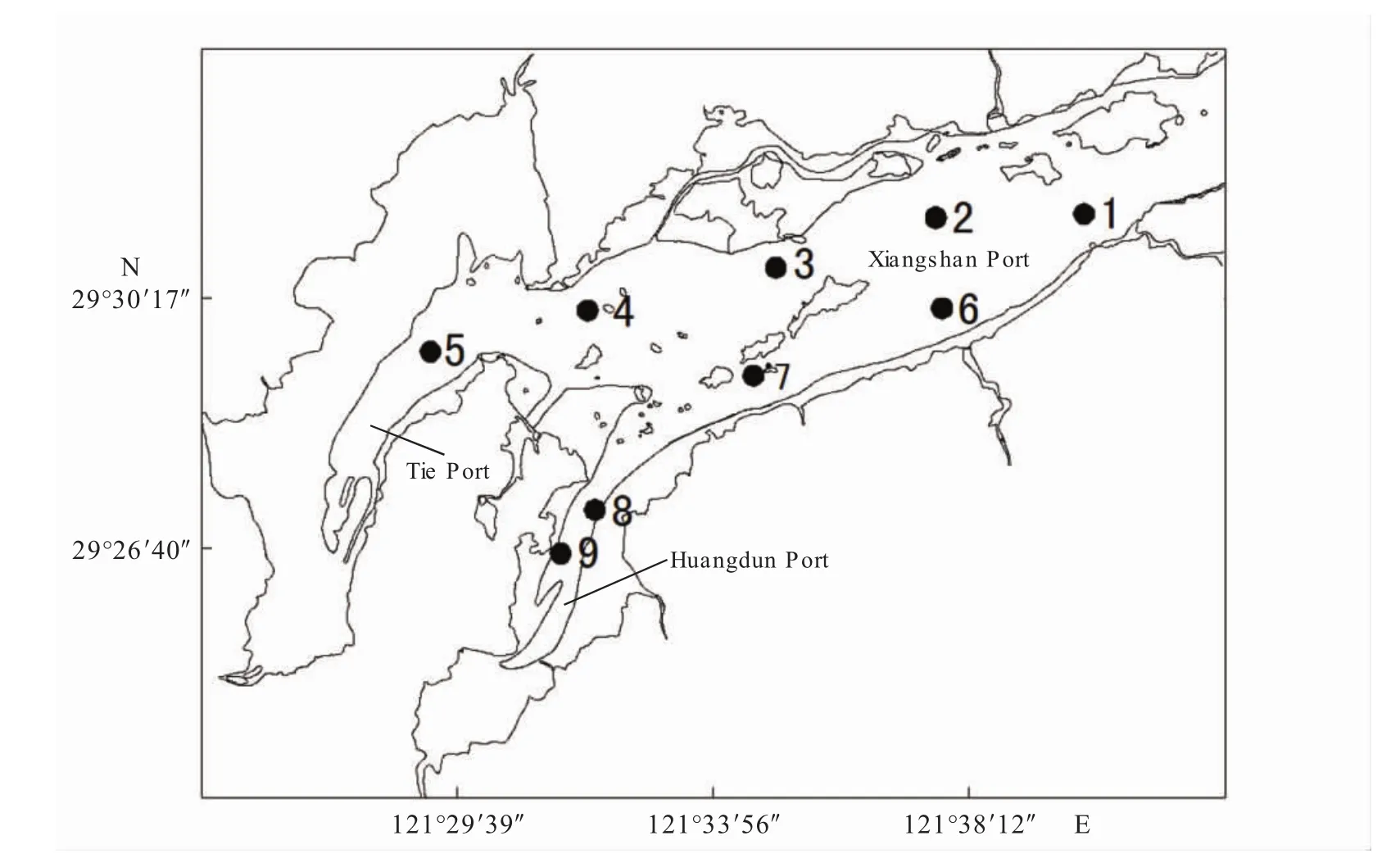
Fig.1 Nine sampling stations in Xiangshan Bay
1.2 Methods
1.2.1 Nutrient element determination and evaluation
Nitrogen and phosphorus contents,which were used as indicators of the nutrient composition of the stations in the survey,were determined according to methods provided in the nationalSpecifications for Oceanographic Survey(GB/T 13909-92).The evaluation method and standards used in this study were based on theTechnical Regulations for the Second National Baseline Survey of Marine Pollution(The second national marine pollution baseline survey leading office,1997),which specifies maximum pollution limits for total nitrogen and total phosphorus of 0.055%and 0.060%,respectively.
Optical microscope samples were prepared according to Hakansson(1984).Samples were treated with 10%HCl to remove calcareous matter and then treated with 30%H2O2(1-2 h in a water bath at 60°C)to remove organic material.Samples were mounted with Naphrax.Diatoms were identified and counted with an Olympus BX-51 microscope.More than 300 diatom valves were counted for each sample,and the counts were converted to percentage abundances.The absolute number of diatom valves per gram of sediment was calculated as follows:the number of valve/g=((N×(S/s))×(V/v))×1 000/w,whereNis the number of diatom valves observed;Sis the total number of rows divided per slide;sis the number of rows in which diatoms were counted;Vis the total volume;vis the volume of solution placed onto cover slip;andwis the dry weight of the sample.Relative abundances of individual taxa are given as percentages(Abrantes et al.,2007).
1.2.2 Calculation of community characteristic indexes
The characteristics of the benthic diatom community were calculated using three indexes(Shen,2002),Shannon-Wiener’s diversity index(H′),evenness(J′)and dominance(Y),according to the following respective formulas:
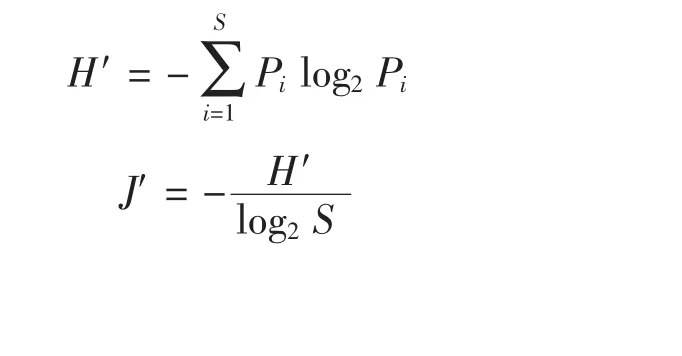

In these formulas,N is the total number of individuals of all sampled species;S is the total number of sampled species;niis the total number of individuals of species i;Pi,which is equal to ni/N,is the ratio of the number of individuals of species i to the total number of all sampled individuals;fiis the frequency of species i in all samples.The dominant species are the species that Y-value greater than 0.02.
2 Results and discussion
2.1 Seasonal variation in environmental factors
2.1.1 The distribution of nitrogen and phosphorus
Total nitrogen ranged from 0.047%to 0.058%in May,while total phosphorus varied from 0.029%to 0.095%.In November,total nitrogen was 0.062%-0.115%,and total phosphorus was 0.025%-0.127%(Fig.2).Except for stations 1,4,6 and 8,the total nitrogen content in May exceeded the values stipulated by theTechnical Regulations for the Second National Baseline Survey of Marine Pollution.The total nitrogen content exceeded the prescribed limit at all stations in November.The total phosphorus content at station 9 in May and November,and stations 2 and 6 in November all exceeded the prescribed limit.The levels of nutrient elements in surface mud at each station were obviously low in spring while high in autumn.

Fig.2 Horizontal distributions of total nitrogen and total phosphorus
2.1.2 Temperature and salinity
During the sampling period,the water temperature above the surface sediment ranged from 15°C to 20.1°C,with average water temperatures of 19.0°C in May and 16.5°C in November.Salinity ranged from 22.05 to 26.77,with an average of 25.75 in May and 23.75 in November.
2.2 Species composition and ecological groups
A total of 179 diatom species(including varieties)in 46 genera were collected(Tab.1).The diversity of diatom species varied by season.In May(spring),164 diatom species in 46 genera were sampled.In November(autumn),the number of diatom species decreased to52 species in 22 genera.CoscinodiscusandNitzschiaexhibited the highest species diversities,namely,30 species and varieties ofCoscinodiscusand 13 ofNitzschia.On the basis of their ecological characteristics,diatoms can be divided into three groups:eurythermal and cosmopolitan species,warm-water species,and temperate-water species.Eurythermal and cosmopolitan species,such asCyclotella stylorumandCoscinodiscus jonesianus,often appeared in May and November.As the dominant benthic diatom groups in Xiangshan Bay,they accounted for two-thirds of total sampled species.The next most abundant benthic diatom group comprised warm-water species,such asTryblioptychus cocconeiformis,Coscinodiscus blandusandPinnularia major.Temperatewater species includedCoscinodiscus kutzingiiandCoscinodiscus curvatulus,which generally were found in colder water.In spring and autumn during the survey,only a small number of individuals appeared.According to the planar distribution of benthic diatom species in the survey area,more species were present in non-aquaculture than aquaculture areas.Up to 80 and 73 diatom species were respectively collected from stations 1 and 6,all of which were non-aquaculture areas.Because of the different levels of aquaculture and fishing activities,the number of species at other stations varied from 37 to 62.Obvious seasonal variations in the number of species were observed at the different stations,suggesting species diversity in May(spring)was higher than that in November(autumn)(Tab.2).
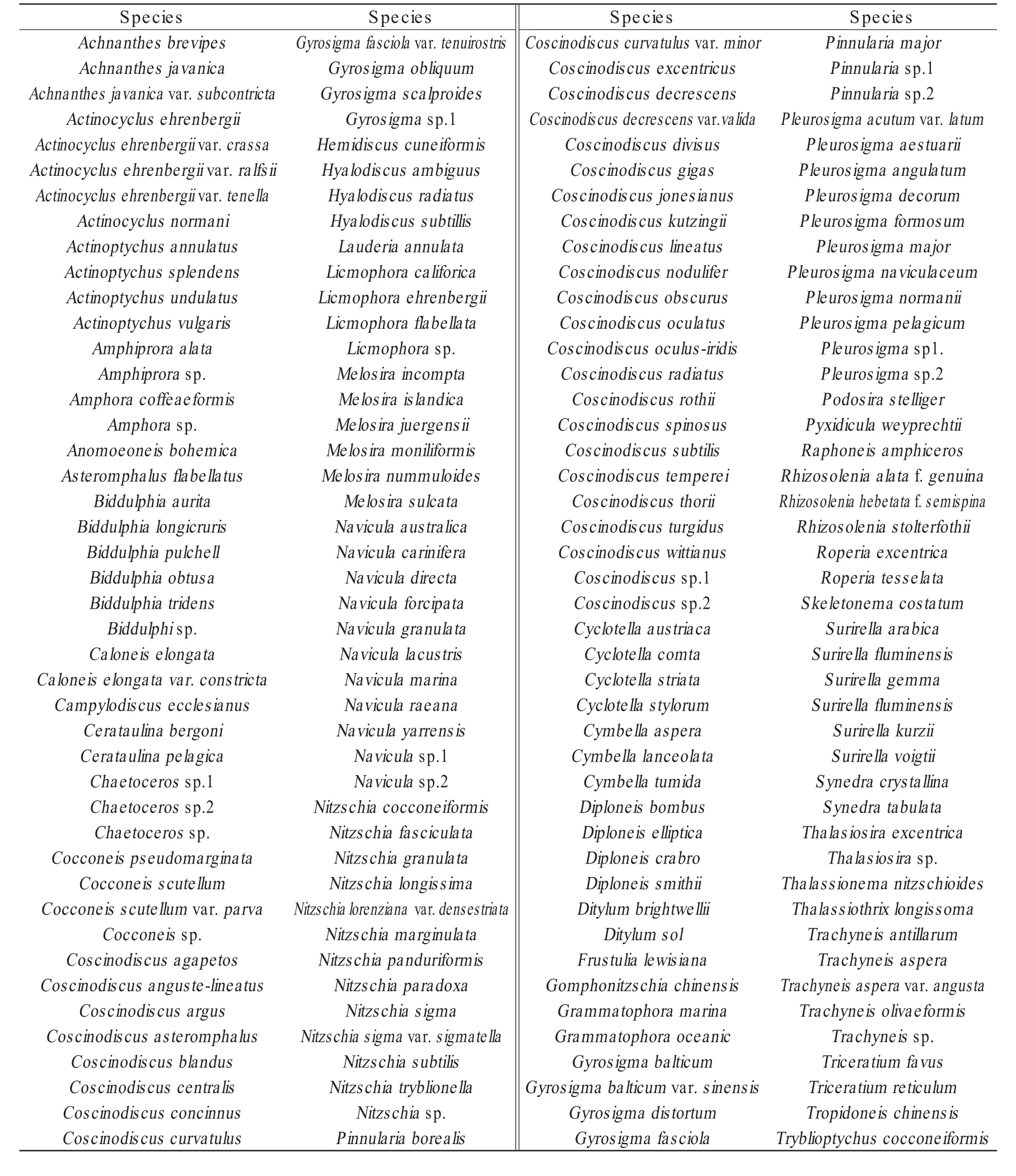
Tab.1 Species composition of diatom

Tab.2 Horizontal and seasonal distribution of diatom species at 9 stations
2.3 Seasonal variation in distributional abundance
The number and distribution of benthic diatoms exhibited obvious seasonal variations.Cell abundance ranged from 0.007×103to 6.851×103cells/g,with an average of 1.522×103cells/g.Diatom abundance was higher in May(spring)than in November(autumn),averaging 2.974×103cells·g-1and 0.071×103cells/g,respectively.Diatom distribution was also significantly different among stations.The highest diatom cell abundance was at station 9,which was located at the upper end of the bay and densely covered infish cages.Cellabundances there were 6.851×103cells/g and 0.143×103cells/g in spring and autumn,respectively.Water exchange at this station was slow and stable,which corresponds to a good ecological environment for benthic diatom growth and reproduction.Stations 3,4,5 and 7,all in fish cage areas,had the next highest diatom abundances:1.840 5×103,1.754×103,1.394×103and 1.3905×103cells/g,respectively.The lowest diatom abundance,at station 2,was 0.507×103cells/g.This abundance varied from 0.975×103cells/g in May(spring)to 0.038×103cells/g in November(autumn),reflecting the non-uniformity of benthic diatom distribution in Xiangshan Bay(Fig.3).

Fig.3 The quantitative distribution of diatom in spring and autumn at 9 stations in Xiangshan Bay
2.4 Distributional characteristics of dominant species
Dominant species at the 9 sample stations are shown in the Tab.3.In spring,the temperature in the bay was suitable for diatom growth,so many dominant species were present.Dominant eurythermal species(and their average cell abundance in sediments)wereCyclotella stylorum(0.521×103cells/g),Coscinodiscus jonesianus(0.284×103cells/g),Actinoptychus undulatus(0.122×103cells/g),Thalassiosira excentrica(0.126×103cells/g),Grammatophora oceanica(0.105×103cells/g),Ditylum brightwellii(0.073×103cells/g)andMelosira moniliformis(0.102×103cells/g).Tryblioptychus cocconeiformis,a warm-water species,had an average cell abundance of 0.087×103cells/g.As temperature is the main factor affecting the composition and distributional abundance of micro-benthic algae,the growth of warm-water diatom species was inhibited when the temperature decreased in autumn.Only a few eurythermal species,such asCyclotella stylorumandCoscinodiscus jonesianus,were dominantin autumn.Their average cellabundances were 0.017×103cells/g and 0.02×103cells/g,respectively.The average salinity of the study area in spring and autumn was 25.75 and 23.75,respectively.This relatively small difference in salinity between the two seasons indicates that the seasonal variation in benthic diatom abundance was not strongly related to salinity.
2.5 Species diversity and evenness
As shown in the Fig.4 Shannon-Wiener diversity index values ranged from 0.918 to 5.353,with an average of 3.562.The highest value was recorded at station 1.The lowest was at station 3,where only a few species,such asCyclotella stylorumandCoscinodiscus argus,were present in November(autumn).As shown in the Tab.3,evenness ranged from 0.63 to 0.982,with an average value of 0.81.The highest evenness was at station 2,and the lowest was at station 9.Although the cell abundance at station 9 was high,the evenness was low because only a single dominant species,Cyclotella stylorum,was present.Because diatom species diversity was high in May(spring),dominant species accounted for a relatively low proportion of the total number,47.7%.The diatom species composition in November(autumn)was relatively simple,with dominant speciesCyclotella stylorumandCoscinodiscus jonesianusaccounting for 51.79%of total cell abundance.The diversity and evenness of the diatom community was therefore low in autumn.
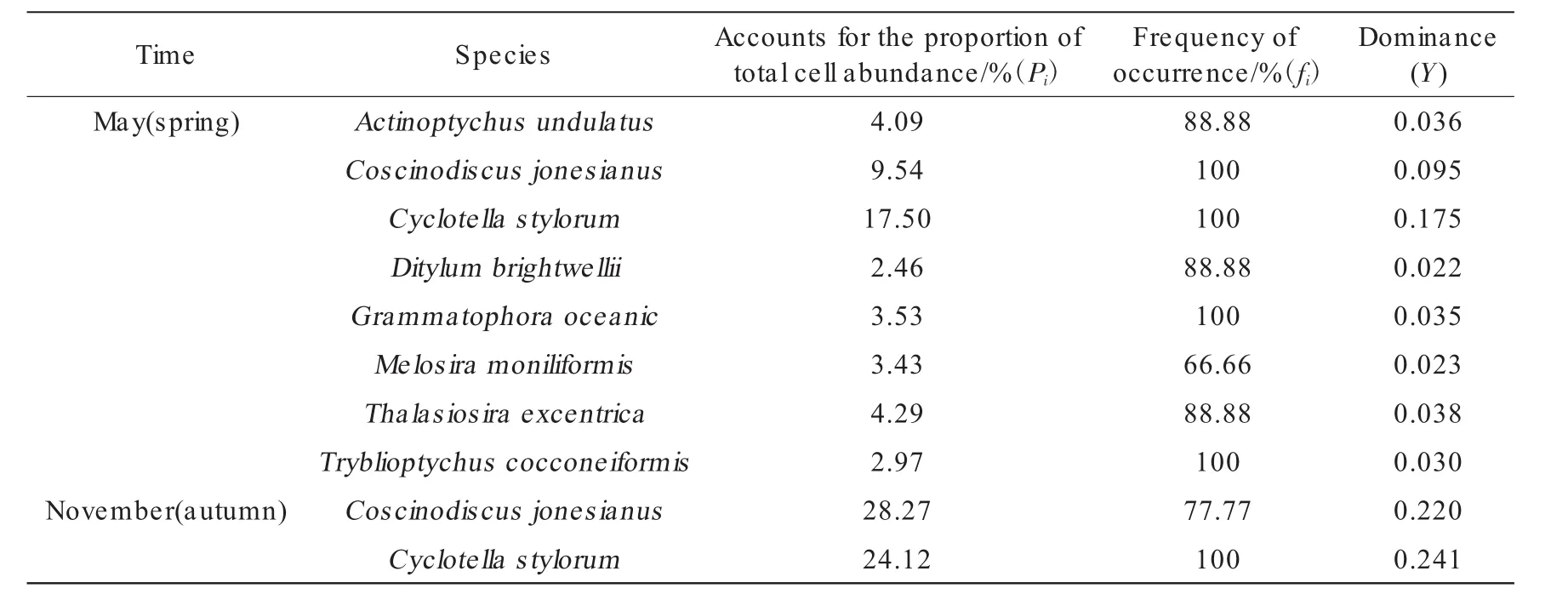
Tab.3 Comparison of the dominant diatom species at 9 sample stations
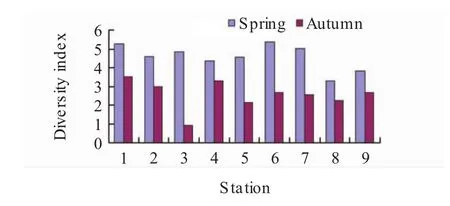
Fig.4 The diversity index
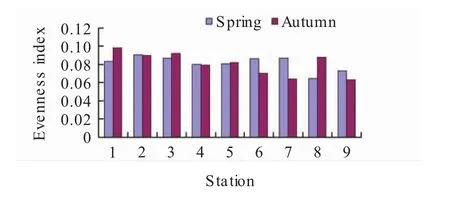
Fig.5 The evenness index
3 Discussion and conclusions
3.1 Temperature-related changes in the species composition and abundance of benthic diatoms
In May,the average water temperature of the surveyed Xiangshan Bay sea area was 19.0°C,and the abundance of benthic diatoms was high,averaging 2.974×103cells/g.The dominant species were eurythermal speciesCyclotella stylorum,Coscinodiscus jonesianus,Actinoptychus undulatus,Thalassiosira excentrica,Grammatophora oceanica,Ditylum brightwelliiandMelosira moniliformisand the warm-water speciesTryblioptychus cocconeiformis.In November,when the average water temperature was 16.5°C,the abundance of benthic diatoms reduced to 0.071×103cells/g,and the only dominant species were eurythermal speciesCyclotella stylorumandCoscinodiscus jonesianus.The growth of warm-water diatoms was inhibited,which indicates that the composition and distributional abundance of benthic diatoms were mainly affected by temperature.This finding is consistent with the results of a previous study of micro-benthic algae(Zhu et al.,1994,1996,1998).
3.2 Effects of total nitrogen and total phosphorus on benthic diatoms
Nutrient element levels in surface mud at each station were low in spring and high in autumn.In May,total nitrogen was 0.047%-0.058%,and total phosphorus was 0.029%-0.095%,while in November,total nitrogen and total phosphorus ranged from 0.062%-0.115%to 0.025%-0.127%,respectively.The total nitrogen content at most stations exceeded the prescribed limit in May,and the level at all stations exceeded the prescribed limit in November.The total phosphorus content at station 9 in May and November and stations 2 and 6 in November exceeded the prescribed limit.These results indicate that the eutrophication in sediments of Xiangshan Bay is mainly caused by nitrogen pollution in spring and nitrogen and phosphorus pollution in autumn.The effect of environmental pollution on diatom diversity appears to be generally low(Odum 1981,Reynolds 1984).Nutrient element levels are higher in autumn than that in spring,however,which suggests that the increase in eutrophication in autumn contributes to the observed seasonal decrease in diatom diversity.
Acknowledgments
This study is funded by the National Key Research and Development Program of China(Grant No.2016YFA0601302)and the Natural Science Foundation of China(Grant No.41876146,No.41476116)and the China-EU Cooperation Project:Ecological farming research in coastal zone composite system(INCO-CT-2004-510706).
We thank Liwen Bianji,Edanz Group China(www.liwenbianji.cn/ac),for editing the English text of a draft of this manuscript.
杂志排行
Marine Science Bulletin的其它文章
- Research progress of micro(nano)plastics in marine survey in China
- Bibliometric analysis of Ecopath model in different ecosystem in China
- An overview of studies on marine macrobenthic community structure and biodiversity in the Bohai Sea
- Introduction to marine emergency forecasting and early-warning system(MEFES)
- Effect of mangrove forest on coastal hazards reduction
- Estimating shoreline response to sea level rise:the equilibrium model
